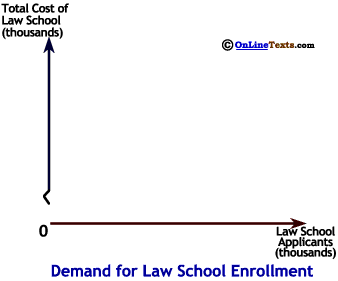
New economics students often find the economic definition of cost or opportunity cost confusing. It isn't obvious at first that the kinds of indirect and implicit costs that are included in our economic cost and profit calculations really matter. The recent increase in law school applications in the U.S. is an excellent example of the importance of these costs, because this increase is due almost entirely to a change in the cost of forgone opportunities, an important indirect cost of attending law school.
The cost of attending law school has fallen dramatically in the last year. Law school tuition hasn't fallen, the cost of law texts hasn't fallen, room and board haven't fallen,1 in fact none of the typical out-of-pocket or direct costs of attending most law schools have fallen. In fact, most of these costs have risen. Nevertheless, the biggest cost of attending law school has fallen, and fallen dramatically. That is, the income that the typical law student gives up by spending three years in law school has fallen enough to lead to a significant increase in the number of students applying to and accepting admission in law schools throughout the U.S.
| Let's consider a simple numerical example of the costs of attending law school for the full three years typically required. Rather than make our calculations long and torturous, we have simplified matters greatly by breaking up the total cost of law school into 4 simple categories: tuition, books, various2 and forgone income. (The numbers to the right are not based on actual figures from any law school nor are they based on an projections; they are chosen simply for the purposes of this example.) Suppose the direct costs of law school continue to rise, but that in 1999 someone who could get into a top law school could expect to earn about $90,000 per year right out of college. Now that the economy is slowing, many firms that were hiring two years ago are laying people off, and many rapidly growing internet businesses that were offering great salaries and stock options to college graduates have gone out of business. Suppose the result is that a student who graduates in 2002 with the same qualifications can expect to earn around $40,000 per year for the first three years after college. As we can see to the right, this reduces the total cost of law school by $127,000, even though all other costs of attending law school have risen. Suppose that things are so bad by the year 2004 that students graduating can barely expect to earn $7,000 per year right out of college (this is very unlikely so don't worry ;). This would make law school cheaper still and further increase applications and enrollment. |
|
||||||||||||||||||||||||||||||||||||||||
Admittedly, these are contrived numbers, but the point they make is very real and is driving the increase in law school applications. Almost 20% more people took the LSAT in June 2001 than took it in June 2000, and an even greater increase is expected for the October, 2001 sitting of the LSAT. As we've shown above, changes in employment opportunities facing college graduates have a huge impact on the cost of law school.3 We can also look at these effects in the context of a simple demand curve.

On the graph to the right we show the Total Cost of Law School (in thousands of dollars) on the vertical axis (the broken portion indicates that part of the vertical scale has been deleted). This is just like the "price" of law school; even though the greatest part of this cost is based on forgone opportunities, it's still reasonable to think of this as the price of law school. Along the horizontal axis we show the number of Law School Applications (in thousands). Just as the Law of Demand predicts, if nothing else changes, a reduction in the price of a good leads to an increase in quantity demanded. In our example, the total cost of law school falls from $392,000 to $250,000, due to changing employment prospects of college graduates. This is true even though the out-of-pocket costs rise. This leads to an increase in the number of applicants from 70,000 to 85,000. If employment opportunities continue to erode, and nothing else changes, the cost of law school will fall farther, and even more students will apply. We don't believe employment opportunities and starting salaries will be this bad, but we show a hypothetical set of numbers for 2004 in which the total cost of law school drops to 180,000 and applicants increase to 95,000.
Whatever the real numbers are, law school applications and enrollment are increasing quickly and this increase can be attributed to a reduction in an indirect cost of law school.
In demand analysis phrases like "if nothing else changes" and "all else being equal" are very important. Decreasing employment opportunities for college graduates lowers the cost of law school increasing quantity demanded, all else being equal. But, what if all else is not equal? For instance, what if employment opportunities for lawyers become worse as well? This may well be happening. Very recently some large law firms have had to lay off attorneys. If this continues, we can expect a shift of the demand curve for law school enrollment shown above. This will change the numbers who would apply at every cost, though the demand curve will still be downward sloping so the law of demand will still hold. We won't go into the effects of a shift in demand in this article, but it's always important to remember in any demand and supply analysis that when things other than price change, demand and supply curves shift. This in turn affects quantities supplied and demanded at every price.